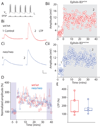Ephrin-B3 regulates glutamate receptor signaling at hippocampal synapses
- PMID: 20678574
- PMCID: PMC2962683
- DOI: 10.1016/j.mcn.2010.07.011
Ephrin-B3 regulates glutamate receptor signaling at hippocampal synapses
Abstract
B-ephrin-EphB receptor signaling modulates NMDA receptors by inducing tyrosine phosphorylation of NR2 subunits. Ephrins and EphB RTKs are localized to postsynaptic compartments in the CA1, and therefore potentially interact in a non-canonical cis- configuration. However, it is not known whether cis- configured receptor-ligand signaling is utilized by this class of RTKs, and whether this might influence excitatory synapses. We found that ablation of ephrin-B3 results in an enhancement of the NMDA receptor component of synaptic transmission relative to the AMPA receptor component in CA1 synapses. Synaptic AMPA receptor expression is reduced in ephrin-B3 knockout mice, and there is a marked enhancement of tyrosine phosphorylation of the NR2B receptor subunit. In a reduced system co-expression of ephrin-B3 attenuated EphB2-mediated NR2B tyrosine phosphorylation. Moreover, phosphorylation of EphB2 was elevated in the hippocampus of ephrin-B3 knockout mice, suggesting that regulation of EphB2 activity is lost in these mice. Direct activation of EphB RTKs resulted in phosphorylation of NR2B and a potential signaling partner, the non-receptor tyrosine kinase Pyk2. Our data suggests that ephrin-B3 limits EphB RTK-mediated phosphorylation of the NR2B subunit through an inhibitory cis- interaction which is required for the correct function of glutamatergic CA1 synapses.
Copyright © 2010 Elsevier Inc. All rights reserved.
Figures







References
-
- Barth AL, Malenka RC. NMDAR EPSC kinetics do not regulate the critical period for LTP at thalamocortical synapses. Nat Neurosci. 2001;4:235–236. - PubMed
-
- Bellone C, Nicoll RA. Rapid bidirectional switching of synaptic NMDA receptors. Neuron. 2007;55:779–785. - PubMed
-
- Carvalho RF, Beutler M, Marler KJ, Knoll B, Becker-Barroso E, Heintzmann R, Ng T, Drescher U. Silencing of EphA3 through a cis interaction with ephrinA5. Nat Neurosci. 2006;9:322–330. - PubMed
Publication types
MeSH terms
Substances
Grants and funding
LinkOut - more resources
Full Text Sources
Molecular Biology Databases
Miscellaneous

